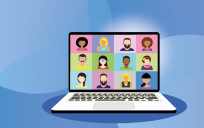Have you met Todd Park? He’s the first CTO of Health and Human Services Department of the United States. Earlier this week, he announced the upcoming launch of HealthData.gov, a new website that will publish open government health data. If you’re unfamiliar with Park, I interviewed him at this year’s Gov 2.0 Expo:
Park and I talked about his open government work at the Department of Health and Human Services, where he’s been trying to make community health information as useful as weather data. We also spoke about the Health 2.0 Developer Challenge, a series of code-a-thons and team competitions to build apps based upon community health data. “Games are a non-trivial information dissemination approach” that can drive actionable behavior, said Park at HealthCamp, referring to many of the entries that use game mechanics to socialize the data. The developer challenge culminated this week during the fourth annual Health 2.0 Conference in San Francisco.
The nation now can see more about what the tech community has come up since this spring, when the question of whether there’s a healthcare app for that was answered the first time. “Social value and economic value can go hand in hand,” he said to a health IT summit in San Francisco. Below, Park talks about the Veterans Administration’s new “Blue Button,” which provides access to downloadable personal health data.
In the video, Park outlines the agency’s plan to offer military veterans and Medicare recipients the ability to download their own health records using a digital “blue button” on MyMedicare.gov and MyHealthyVet. Fried reported on veterans getting downloadable health info at CNET.com. Park, VA CTO Peter Levin and federal CTO Aneesh Chopra blogged about the Blue Button at WhiteHouse.gov:
Veterans who log onto My HealtheVet at www.myhealth.va.gov and click the Blue Button can save or print information from their own health records. Using a similar Blue Button, Medicare beneficiaries who are registered users of www.mymedicare.gov can log onto a secure site where they can save or print their Medicare claims and self-entered personal information. Data from of each site can be used to create portable medical histories that will facilitate dialog with Veterans’ and beneficiaries’ health care providers, caregivers, and other trusted individuals or entities.
This new option will help Veterans and Medicare beneficiaries save their information on individual computers and portable storage devices or print that information in hard copy. Having ready access to personal health information from Medicare claims can help beneficiaries understand their medical history and partner more effectively with providers. With the advent of the Blue Button feature, Medicare beneficiaries will be able to view their claims and self-entered information—and be able to export that data onto their own computer. The information is downloaded as an “ASCII text file,” the easiest and simplest electronic text format. This file is also easy to read by the individual; it looks like an organized report.
More than 60,000 people have already downloaded their PHRs. As those technically savvy writers emphasize, however, this will create thousands of opportunities to have that sensitive data leak. They stressed the importance of using encryption and password protection to protect the records. For those watching the development of health IT, the future that the 3 CTOs hint about near the end of the post will be of particular interest:
Soon, Blue Button users may be able to augment the downloaded information that is housed on their computers—or that they transferred to a commercial personal health record or other health application—through automated connections to, and downloads from, major pharmacies including Walgreens and CVS; lab systems such as Quest and LabCorp; and an increasing number of inpatient and outpatient electronic medical records systems.
Keep an eye out for how that develops.
Below, Park kicks off the Healthcamp SF Bay event.
Here are his slides from the event:
Below, he summarizes his Healthcamp session.




Wow, lots to digest. Are there plans to do follow-up on a) how people use the Blue Button and b) how it changes people’s health and behaviors?